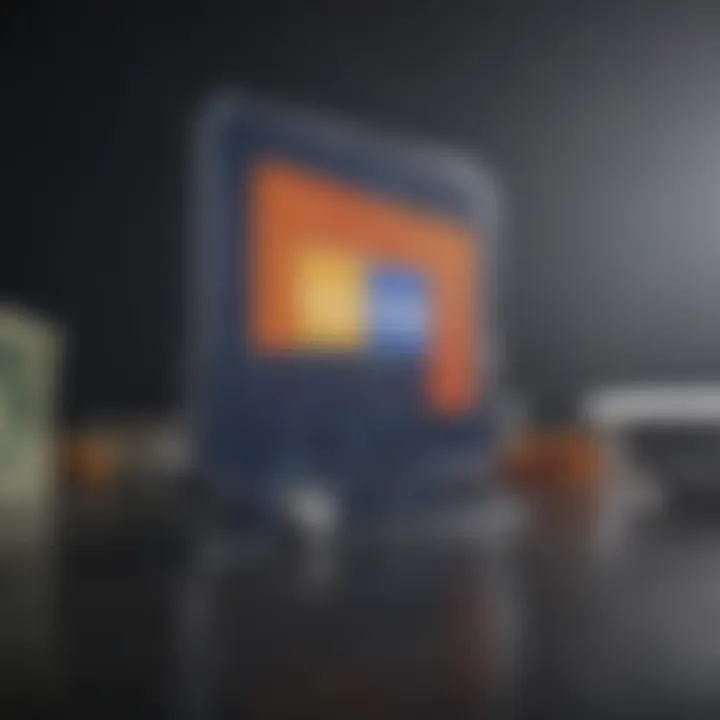Understanding Facebook Advertising Costs Effectively


Intro
In the realm of digital marketing, Facebook advertising has carved a niche that both beginners and seasoned investors recognize. However, understanding the costs associated with Facebook ads is more complex than simply setting a budget and running campaigns. This analysis dives into the intricacies that determine how much advertisers will spend on the platform, weaving through various strategic elements that influence these financial decisions. By grasping the factors that play a role in the pricing structure, advertisers can enhance their approach and allocate funds more effectively.
Exploring this topic isn't just academic; it’s a practical necessity for anyone looking to optimize their marketing efforts on one of the largest social media platforms globally. This article breaks down essential terms, insights from industry professionals, and offers a thorough lens through which to view Facebook advertising costs.
Key Definitions
Understanding financial terminology is crucial for navigating Facebook advertising costs. Below are some key definitions that will serve as a compass while exploring the deeper layers of this subject.
Essential Financial Terms
- CPM (Cost Per Mille): The price an advertiser pays for one thousand impressions of their ad. It's a common metric used to gauge ad effectiveness relative to budget.
- CPC (Cost Per Click): This refers to the amount of money an advertiser pays for each click on their ad. This method can be beneficial for campaigns focused on driving traffic to a specific site.
- CTR (Click-Through Rate): This measures the ratio of clicks to impressions, reflecting how effectively an ad engages its audience. A higher CTR means that more people are responding positively to the ad's creative elements.
Terminology Breakdown
- Ad Auction: A competitive process where Facebook determines which advertisements to display based on bids and ad relevance. Understanding this model helps advertisers adjust their strategies to win more visibility.
- Bidding Strategy: Different approaches advertisers can use to manage their costs, including options like manual bidding and automatic bidding, aligning spending with campaign goals.
- Ad Relevance Score: A metric that indicates how well an ad resonates with its target audience, which can greatly affect costs due to competition and click rates.
"A well-informed approach is essential for maximizing advertising returns on Facebook."
Expert Insights
The landscape of social media advertising is ever-evolving, and staying ahead means understanding investment strategies and the broader market trends.
Investment Strategies Explained
Investing wisely in Facebook advertising requires a balanced approach. Here are some strategies to consider:
- Allocate Budget Wisely: Start with a moderate budget and adjust based on performance. Testing different ad sets can yield valuable data on which strategies work.
- Focus on Audience Targeting: Tailoring your ads to a specific audience can dramatically improve cost-efficiency. Take advantage of Facebook's audience insights to hone in on demographics that align with your goals.
- Utilize Retargeting: Setting up retargeting campaigns can lower costs by engaging users who showed previous interest in your offerings.
Market Trends and Analysis
Keeping an eye on trends is essential for successful campaigns. Key observations include:
- In recent years, competition for ad space has escalated, particularly during holidays and special events. This seasonal factor can impact overall costs.
- Video ads are gaining traction and typically see higher engagement. Invest in creative, quality video content to capitalize on this trend.
- Opting for A/B testing can help clarify which strategies yield the most favorable results, allowing for data-led decisions.
By weaving these insights together, advertisers can craft a strategy that not only fits their budget but aligns with their overall marketing objectives.
Preface to Facebook Advertising
When it comes to digital marketing, Facebook stands tall among the giants. With billions of users connected daily, businesses find a goldmine of opportunities lurking within this platform. Facebook advertising isn’t just a trendy option; it’s practically a prerequisite for brands aiming to reach their audience effectively. There’s a knack to it, and that’s where understanding the intricacies of Facebook advertising costs comes into play.
This article will untangle the complexities surrounding pricing models, explore average expenditures, and dissect essential factors that impact costs. Getting a grasp on these key elements helps advertisers navigate the often murky waters of Facebook ads, ensuring that both seasoned marketers and newcomers alike can employ strategies that maximize their return on investment—ROI—in a world where every cent counts.
The Importance of Facebook as an Advertising Platform
Facebook isn’t just a social media site; it has evolved into a powerhouse for advertisers. Its ability to target specific demographics makes it a compelling choice. Advertisers can narrow their audience based on interests, behavior, age, location, and more. This level of precision is something that can be hard to find elsewhere.
Furthermore, Facebook's data-driven approach means that ads aren’t just shot into the void. The platform continually analyzes metrics, providing insights that can lead businesses to refine their strategy over time.
Some of the benefits of using Facebook for advertising include:
- Robust Targeting Options: Brands can catch potential customers where they frequently spend their time.
- Variety of Ad Formats: From videos to carousel ads, there’s something for every marketing style.
- Cost Control: You can set your budget and bid based on your understanding of your own financial capabilities.
In a nutshell, if you’re not utilizing Facebook as an advertising avenue’, you may very well be missing the boat.
Current Trends in Digital Advertising
In the digital age, keeping up with trends is akin to navigating a moving target. What’s hot today may be old news tomorrow. Currently, some trends are reshaping how advertisers view and interact with platforms like Facebook, including:
- Video Dominance: Videos are being prioritized over static images, capturing user attention more effectively.
- Personalization: Personalized ads are a hit. Audiences prefer content that speaks directly to their interests.
- Mobile Optimization: As more users access Facebook through their smartphones, ads increasingly need to be mobile-friendly.
These progressive shifts mean that advertisers constantly have to rethink their strategies to stay relevant. Ignoring these trends can cost brands dearly in terms of engagement and success.
"In advertising, creativity is like the engine and data is the fuel. Without both, the journey can stall."
Consequently, understanding the landscape of Facebook advertising is not merely beneficial; it is essential to thrive in an increasingly competitive marketplace.
Pricing Models of Facebook Advertising
When any business decides to dip their toes into Facebook advertising, one of the first things they wrestle with is the pricing model. What’s essential to grasp here is not merely the numbers, but how these models shape advertising strategies and outcomes. Understanding pricing models – Cost Per Click (CPC), Cost Per Impression (CPM), and Cost Per Action (CPA) – is vital as they guide how a business can allocate its budget effectively.
Each model comes with its own distinct set of advantages and considerations, enabling advertisers to pick the right one based on campaign goals. For instance, while CPC is fantastic for driving traffic, CPM can be suitable for building brand awareness. Companies need to repeatedly evaluate which model suits their specific objectives, target audience, and budget constraints.
Cost Per Click (CPC) Explained
Cost Per Click (CPC) is like pay per shot; you only pay when someone clicks on your ad. This model works beautifully if your aim is to generate traffic to a website or landing page. In essence, it’s all about offering a clear path to conversion. If a click does not lead to a conversion, the cost may seem wasted. But here's the trick: with effective targeting and engaging creative, many clicks can lead to favorable outcomes.
In practice, the CPC fluctuates based on competition, the quality of the ad, and targeting precision. It's crucial to keep an eye on this metric, as high CPC can eat into advertising budgets quickly
- Benefits of CPC include:
- Direct measurement of ad effectiveness
- Greater control over spending
- Focus on tangible actions (clicks) vs. impressions
However, a blunderous focus on merely achieving clicks can lead to low-quality visitors, which negatively impacts conversion rates. Hence, CPC campaigns require a mix of creativity, strong call-to-actions, and precise audience targeting.
Cost Per Impression (CPM) Overview
Cost Per Impression (CPM) operates on a different wavelength, where advertisers pay for each thousand impressions their ads receive. For businesses, this translates to gaining visibility rather than interactions. It’s like throwing a wide net to attract prospects. This method can be particularly advantageous for those aiming to establish brand recognition or launch a new product.


However, one must be cautious. Not every impression means engagement, and this model can end up feeling like a gamble. Imagine investing in exposure rather than interaction; if your brand isn’t resonating, those impressions might be worth less than their cost.
Consequently, KPI assessment becomes crucial. Advertisers should pay attention to their reach and engagement metrics to ensure that their campaign is not just throwing money into the wind.
- Key points to consider with CPM:
- Ideal for brand awareness strategies
- A potential for extensive reach
- Needs strong creative to engage viewers even when not clicked
Cost Per Action (CPA) Insights
Cost Per Action (CPA) is often considered the holy grail of Facebook advertising, as it focuses on actions – be it a purchase, sign-up, or download. This model is about paying for results that matter most to advertisers. You only shell out money when a desired action is taken, protecting the budget from the unpredictability of mere clicks or impressions.
Yet, one must note that CPA can lead to higher upfront costs. Achieving a favorable CPA requires significant time and effort in audience segmentation and setting target outcomes. It favors those with a clear understanding of their conversion funnel. Here lies the challenge: aligning ad creativity with the user’s path to conversion must be a delicate balance.
- Advantages of CPA include:
- Directly correlates spending with actions
- Reduced risk as you only pay for desired outcomes
- Effectiveness in re-targeting campaigns where audience intent is known
When deploying CPA strategies, keeping a close watch on analytics is imperative to optimize ad performance and maximize return on investment.
"Picking the right pricing model isn't just about cost; it's about aligning your marketing goals with financial viability."
Ultimately, understanding these pricing models equips advertisers with the knowledge to sculpt their campaigns effectively, ensuring every dollar spent is a dollar well-used.
Factors Influencing Facebook Advertising Costs
When it comes to Facebook advertising, understanding what drives the costs can make or break a campaign. This section shines a light on the myriad of factors that can affect these expenses and highlights why knowing these elements is crucial for any advertiser, newbie or veteran alike. The goal here is to answer the big question: What can you do to keep your ad spend efficient while maximizing return on investment?
Target Audience Characteristics
The backbone of successful advertising on Facebook often lies in the target audience. The specificity of your audience can dramatically change your costs. For instance, targeting a broad demographic usually leads to higher costs due to greater competition. In contrast, narrowing down your audience to a specific age group or interest can lead to lower costs because you're competing with fewer advertisers.
Additionally, the behaviors and interests of the audience play a role. If you are aiming for a niche market that is less sought after, you might find the costs are lower. Conversely, if the audience consists of potential customers who are highly engaged or in a popular sector, it would naturally push costs up. It's like fishing; if you’re casting a wide net, you might catch some fish, but casting a smaller, more focused net often yields more targeted results at a better cost.
Ad Relevance and Quality Score
The relevance of your ad significantly influences your costs as well. Facebook has a complex algorithm that evaluates how well your ad resonates with your chosen audience. This leads to what's known as a Quality Score. A high Quality Score can reduce your costs per click or impression, whereas ads with low relevance can lead to higher costs as the platform sees them as less worthy of user attention.
You can enhance ad relevance by ensuring your content aligns closely with your audience's interests and needs. Using targeted keywords, compelling visuals, and clear calls to action can improve relevance. Think of it as throwing a stake on a grill; if the meat is good and seasoned well, more will come back for seconds. The better the quality of your ad, the lower your costs, and the higher your conversion rates.
Competition and Bid Strategies
Competition plays a key role in determining Facebook advertising costs. When many businesses bid for the same audience or ad space, it can drive costs up. It’s essential to know not just who your competitors are, but also what strategies they are employing.
Setting effective bids involves understanding your campaign goals. For instance, if you seek brand awareness, you might opt for a lower bid to gather traction over time. However, if immediate customer actions are your goal, you’ll want to utilize a more aggressive bidding strategy.
In this dynamic arena, flexibly adjusting your bids based on performance and competition is crucial. It can feel like a chess game, where being aware of the moves your competitors are making can lead to smarter expenditures.
Ultimately, navigating these factors requires continuous learning and adjusting strategies. Keeping a vigilant eye on audience dynamics, ad effectiveness, and competitive bids can help maximize your advertising budget allocation.
"In advertising, understanding your costs is as important as the message you're trying to convey. Don't just throw money at ads; be strategic."
By grasping these influential factors, advertisers can tailor their approach to ensure that every dollar counts in their Facebook advertising campaign.
Average Advertising Costs on Facebook
Understanding how much advertising on Facebook typically costs is essential for any marketer or business owner looking to leverage this powerful platform. It's not just about throwing money at ads and hoping for the best; knowing the average costs allows you to make better financial decisions, optimize your advertising strategy, and ultimately, get the most out of your budget. The costs involved can vary significantly based on factors such as industry, target audience, and advertising objectives.
The benefit of having a grasp on average advertising costs lies in the ability to set realistic expectations for budget allocation. By understanding where your spending stands compared to industry averages, you can navigate your advertising strategy with confidence. This section will take a closer look at two pivotal aspects: industry-specific cost analysis and geographic differences in pricing, which can greatly impact how your advertising dollars stretch.
Industry-Specific Cost Analysis
Different industries have different benchmarks when it comes to Facebook advertising costs. Some sectors, like finance or legal services, often face higher costs per click or impression compared to e-commerce or local services. Here’s why:
- High Competition: In industries with more advertisers, the competition for clicks becomes fierce. This drives up costs, as everyone is vying for the same audience.
- Target Audience Value: If an industry serves a high-value target audience—like individuals seeking investment advice—the cost to capture those leads goes up.
- Ad Relevance: Not all industries are created equal when it comes to the relevance of ads. An ad that resonates well with its audience might produce better results at a lower cost than a poorly targeted ad from a completely different sector.
Average Costs by Industry
For instance, here’s a quick overview of average costs for different industries:
- E-commerce: Often sees CPC rates close to $0.50 to $1.50.
- Finance: Might range from $3 to $5 per click, reflecting high competition for high-value customers.
- Real Estate: Generally, $1 to $3 per click, with variances depending on geographic area.
Understanding these industry-specific pricing metrics can provide a strategic advantage by informing budget strategies and advertising approaches based on your particular sector.
Geographic Differences in Pricing
Location plays a significant role in Facebook advertising costs as well. Prices can vary greatly based on where your target audience is located. Here’s how geography comes into play:
- Population Density: Major metropolitan areas usually have higher advertising costs due to the larger concentration of users. For example, targeting New York City may cost more than targeting a small town in the Midwest.
- Regional Economic Factors: Some regions may have different consumer purchasing power, affecting how much a business is willing to spend on ads.
- Cultural Differences: Understanding local preferences and behaviors can also impact the effectiveness and therefore the cost of ads in different areas.
Pricing Variations Across Regions
To put things into perspective, here are rough average CPCs by region:
- North America: $1.00 to $2.50
- Europe: $0.50 to $2.00
- Asia: $0.20 to $1.50
These geographic variances can significantly affect cost strategies, making it crucial for marketers to tailor their advertising efforts according to the demographics of their target audience.
The effectiveness of your Facebook advertising is not just determined by how much money you spend but also by how well you understand the contextual elements influencing those costs.
Strategies for Allocating Your Advertising Budget


Understanding how to allocate your advertising budget on Facebook is crucial for achieving successful outcomes. In the world of digital marketing, budgets are often tight, and making the most of every dollar spent is essential. When you know how to properly allocate your funds, you ensure that you’re not just throwing money at ads but rather investing in strategies that yield results.
Investing time into budget allocation goes beyond simple arithmetic; it involves strategy, foresight, and a clear understanding of your campaign goals. When considering how to divide your budget, key elements like your target audience, the ad format being used, and even the timing of your campaigns come into play. The more thought you put into your allocations, the better you will tune your campaigns for effectiveness.
Setting Clear Campaign Objectives
First off, it is paramount to establish clear campaign objectives before you begin distributing your budget. Knowing what you want to achieve—whether it’s driving traffic to your website, generating leads, or simply raising brand awareness—lays the groundwork for determining how much to spend and where.
When your objectives are clear, it makes evaluating your budget much simpler. For example, campaigns aimed at brand awareness may require different resources compared to direct sales initiatives. Setting goals allows you to create measurable paths and milestones, turning vague intentions into concrete actions. It can also help in communicating with stakeholders, ensuring that everyone is aligned with the objectives.
Balancing Between Brand Awareness and Conversion Focus
Balancing between brand awareness and conversion focus can feel like walking a tightrope, but it’s necessary for a well-rounded marketing strategy. Brand awareness initiatives boost visibility, allowing potential customers to familiarize themselves with your brand, but they might not yield immediate sales. On the other hand, conversion-focused campaigns drive direct sales but may not necessarily cultivate long-term recognition.
An effective strategy usually involves a blend of both. Here’s a way to consider it:
- Allocate a portion of your budget to campaigns that focus on brand awareness during peak visibility periods.
- Channel funds into conversion-focused campaigns during strategic times, like a product launch or seasonal sales.
By constructing your budget in a balanced manner, you can straddle the line between growing your audience and driving immediate sales. The key is to periodically assess performance data and adjust your allocations accordingly.
"Results aren’t just about how much you put in; they’re about placing your bets wisely."
Ad Formats and Their Cost Implications
In the realm of Facebook advertising, the format in which your message is delivered can significantly impact both engagement and costs. Different ad formats cater to various objectives, from raising brand awareness to driving conversions. Understanding these formats and their cost implications is crucial for advertisers who want to maximize their return on investment (ROI). As more businesses flock to Facebook, it’s essential to choose wisely and align your ad format with your marketing goals.
Image and Video Ads: Cost Comparison
Image and video ads are among the most popular formats for Facebook campaigns. They inherently possess different cost structures due to the resources involved in their production and engagement potential. Typically, image ads tend to be more affordable because they require less production time and resources compared to video ads, which can involve higher costs for shooting and editing.
When comparing average costs, image ads might range from an estimated few cents to a couple of dollars per click, depending on targeting and quality variables. However, video ads—while generally pricier—are known to yield higher engagement rates, which can often justify the increased expenditure. If your budget permits, investing in video ads could help create a more dynamic connection with your audience, delivering richer storytelling.
"The format of your ad is more than just a delivery method; it's the first impression your audience gets. Make it count!"
Carousel and Slideshow Ads Overview
Carousel and slideshow ads offer unique advantages that can influence their pricing structures. Carousel ads allow advertisers to showcase multiple images or videos within a single ad unit, presenting a range of products or storytelling elements in one go. This interactivity can enhance engagement and lead to a higher click-through rate.
In terms of costs, carousel ads might lean towards the higher end of the spectrum, especially if utilizing vivid visuals or compelling content. Meanwhile, slideshow ads, which generate motion from a series of images, can be a cost-effective alternative. These allow brands to capture attention without the substantial costs associated with full video production. The choice between them should depend on your creative assets and specific campaign goals.
Dynamic Ads and Their Pricing Model
Dynamic ads are distinct in their ability to automatically display personalized product recommendations to users based on their interests and behavior. This format is particularly useful in eCommerce, as it can be adjusted based on inventory and user engagement, potentially leading to high conversion rates.
The pricing model for dynamic ads can vary based on the sophistication of the targeting employed. They can incur higher costs due to their complexity and the potential for achieving better ROI through personalized outreach. Brands that fully leverage the capabilities of dynamic ads might see increased costs upfront but can benefit from a stronger return as these ads target users who are already shown interest in their offerings.
Effective Targeting Strategies
In the world of Facebook advertising, effective targeting strategies can mean the difference between the success and failure of a campaign. By zeroing in on the right audience, marketers can optimize their spending while simultaneously improving engagement rates. Essentially, if you're not talking to the right people, your message could get lost like a needle in a haystack. Targeting effectively shouldn't just be seen as an option; it's a vital element of any Facebook advertising strategy.
Understanding Audience Segmentation
Audience segmentation is a vital piece of the puzzle when it comes to Facebook ads. It involves breaking down a larger audience into smaller, more manageable groups based on specific characteristics or behaviors. Think about it this way: trying to reach everyone on Facebook is akin to throwing spaghetti at the wall and hoping something sticks. Instead, segmentation gives advertisers a clearer shot at their ideal customers.
Some common factors for segmentation include:
- Demographics: Age, gender, education level, and income can all influence ad effectiveness. A twenty-something might not relate to ads meant for retirees, and vice versa.
- Interests: Targeting based on user interests can help advertisers create personalized messages that resonate deeply. For instance, a fitness brand might prioritize ads for gym enthusiasts over casual walkers.
- Behaviors: This includes past purchase behavior and online activity. By analyzing how users have acted before, marketers can craft offers that feel more relevant and timely.
By diving deep into these segments, advertisers can tailor their messaging effectively, enjoying not just lower costs but a more engaged audience as well. This is where the magic of understanding your audience comes into play.
Utilizing Lookalike Audiences for Cost Efficiency
Building on the foundation of audience segmentation, lookalike audiences present a powerful tool in the ad arsenal. This strategy allows advertisers to take existing customer data and find new users who share similar qualities—think of it as hunting for new customers in a crowd that resembles your best clients. Lookalike audiences are particularly effective because they draw on data-driven insights, reducing the guesswork in targeting.
Here’s why it’s smart to leverage lookalike audiences:
- Expanded Reach: Rather than marketing to a small, specific audience, advertisers can tap into a broader base that mirrors their best customers. This can lead to more conversions at a lower cost.
- Cost Efficiency: By focusing ads on users who already resemble a business's existing customers, the chances of engagement improve dramatically, which often translates into lower cost per acquisition.
- Less Time Consuming: Creating a lookalike audience means you don’t have to constantly research new target groups. It streamlines the process and allows marketers to focus on creating better content instead.
Picture this: you’ve got a loyal customer base, and you want to expand. Instead of pouring money into ads that might not hit the mark, you craft a lookalike audience and serve them your best-performing content. If you're out hunting and you know what to look for, your efforts become more fruitful.
"In advertising, targeting the right audience is like having a well-aimed arrow; it ensures your message hits the bullseye."
Ultimately, effective targeting strategies are crucial to navigating the intricate landscape of Facebook advertising costs. Being savvy about audience segmentation and lookalike audiences can pave the way for more cost-effective and successful ad campaigns.
Analyzing and Measuring Advertising Performance
Analyzing and measuring advertising performance is not just a process; it’s a compass guiding advertisers toward achieving their goals on Facebook. In a landscape where every penny counts, understanding how ads perform can lift your campaigns from mediocre to stellar. When you break it down, what you’re really doing is peeling back the layers on your advertising efforts to see what’s working, what needs a tweak, and where your budget might be better allocated.
The Importance of Performance Analysis
The crux of why measurement matters lies in the need for optimization. Facebook offers an array of tools to gauge performance metrics, allowing marketers to dig deep into the data. With the right KPIs in hand, you can shape your advertising strategy based on hard facts rather than gut feelings. Cutting out the guesswork leads to improved spending efficiency and, ultimately, better ROI.
Moreover, an effective analysis also unlocks insights into your audience. You get to understand who’s engaging with your ads, enabling you to tailor your messaging and targeting more accurately. Think of it as tuning a musical instrument; the better you understand the notes, the more harmonic your performance.
"What gets measured gets managed."
This saying captures the essence of tracking your advertising performance. When you begin to monitor key metrics regularly, you find yourself making informed decisions that lead to genuine improvements in your campaigns.
Key Performance Indicators (KPIs) to Track
KPIs serve as your performance indicators, offering a snapshot of how well your advertisements are resonating with the target market. Here’s a look at essential KPIs to keep an eye on:


- Click-Through Rate (CTR):
Measures how many people clicked on your ad compared to how many saw it. A higher CTR suggests that the ad is relevant and appealing. - Conversion Rate:
This one tells you how many clicks translated into a predefined action, such as a purchase or a sign-up. It’s the heartbeat of your campaign effectiveness. - Cost Per Click (CPC):
Tracking how much you’re paying for each click gives insight into the cost-effectiveness of your ads. - Return on Ad Spend (ROAS):
This measures the revenue generated in relation to what’s spent on ads. It’s crucial for understanding profitability. - Engagement Rate:
Indicates how users interact with your content through likes, shares, and comments, giving an indication of ads’ appeal.
By focusing on these KPIs, advertisers can hone their campaigns to drive more refined results. It’s about knowing the score, so you can play the game smarter.
Adjusting Strategies Based on Analytics Insights
Once you gather enough data, it’s time to roll up your sleeves and get to work. Adjusting your strategies based on embedded analytics isn’t just commonplace; it’s vital. If you notice that certain ads are flopping, it may be time to rethink their design or the audience you’re targeting.
Here are a few practical approaches to tweaking your strategy based on insights:
- Optimize Ad Creative:
If CTR is low, consider refreshing the imagery or copy. Sometimes, even a simple change in wording can make a world of difference. - Retarget Visitors:
If certain visitors clicked but didn’t convert, consider retargeting them with tailored messages that address potential hesitations. - Adjust Audience Targeting:
Dive deeper into your audience data. If your ads aren't landing as expected, it might mean you’re fishing in the wrong pond. Reassess demographic or interest-based criteria. - Test and Learn:
Conduct A/B testing to determine which ads perform better. It’s a straightforward yet effective way to optimize performance over time. - Monitor Seasonal Trends:
Understand that behavior changes with seasons or events. Tailoring your ads to these fluctuations can significantly enhance engagement.
Remember, the data you collect isn't just numbers; it's a narrative about how your audience interacts with your brand. Adjusting your strategies accordingly can carve out a pathway to greater success and, ultimately, higher returns on your advertising investment.
Common Challenges and Pitfalls in Facebook Advertising
Navigating the landscape of Facebook advertising requires more than just setting up a campaign and hoping for the best. Advertisers, whether seasoned pros or fresh faces, face hurdles that can complicate the entire process. Understanding these challenges not only helps in crafting better strategies but also positions advertisers to adapt effectively when things don't go as planned.
By recognizing the pitfalls, marketers can save both time and money. This section unpacks the most common difficulties advertisers encounter on Facebook, ensuring a smoother journey through the ads space.
Understanding Ad Fatigue
Ad fatigue is a hidden monster in the realm of Facebook advertising. Simply put, it refers to the gradual decline in performance of ads as the target audience sees them repeatedly. It’s like watching the same movie on repeat—eventually, it loses its charm. This scenario often leaves advertisers scratching their heads, wondering why their engaging content turned stale.
Several factors contribute to ad fatigue:
- Frequency of Impressions: When the same users see an ad too often, the excitement diminishes. Ideally, advertisers should track how many times a single individual encounters their ad, striving to keep it at a healthy level.
- Audience Saturation: Focusing too narrow on the same audience can lead to quick saturation. Expanding targeting options not only helps reach new eyes but revitalizes the ad’s perception if reintroduced.
- Creative Staleness: Over time, that catchy jingle or vibrant image can become dull to your audience. Regularly refreshing creative content is essential to maintain interest.
"Consistent evaluation of ad performance can shine a light on rising fatigue levels. By tracking engagement metrics, advertisers can pivot creatively while still achieving their goals."
Dealing with Algorithm Changes
Changes to the Facebook algorithm can feel like walking on shifting sands. Each tweak impacts how ads are shown to users, which can shake things up significantly for advertisers. New features, updates in policy, or shifts in user behavior influence where your dollars go and how effective they are.
Understanding the implications of these changes can be daunting, but some strategies can ease the transition:
- Stay Informed: Regular checks on Facebook's official updates can provide a heads-up on algorithm shifts. Knowledge is power, especially in a fast-moving environment.
- Experiment and Adapt: Be prepared to test various ad formats, targeting options, and budgets. If one approach begins to underperform, being agile allows for quick pivots to more fruitful strategies.
- Engage with the Community: Online forums like Reddit or groups on Facebook itself can be invaluable resources. Learning from the experiences of others in the field can provide insights on adjusting to a new algorithm landscape.
In summary, awareness around ad fatigue and fluctuations in Facebook's algorithm equips advertisers with the tools they need to face challenges head-on, turning potential stumbling blocks into stepping stones toward campaign success.
Future Trends in Facebook Advertising Pricing
The world of advertising is like a river; it flows with constant change, shaped by various influences. This is especially true for Facebook advertising costs, which are poised to experience shifts tied to broader technological and market forces. Understanding these trends can not only save costs but also provide a competitive edge. In this section, we dive into two significant elements shaping the future pricing landscape for Facebook advertisers: the influence of artificial intelligence and the dynamics of emerging markets.
The Influence of AI on Cost Structures
AI isn't just a buzzword; it's reshaping our approach to advertising. The cost structures of Facebook ads are gradually being influenced by sophisticated algorithms that optimize ad placements, targeting, and bidding strategies. These AI models analyze a wide array of data, from user engagement metrics to historical ad performance, and refine how budgets are allocated.
Consider this: a company wants to run a campaign on Facebook. With AI, it can easily analyze past successes to identify the ideal audience. It will also dynamically adjust bids based on real-time data, ensuring their budget is spent where it counts most. In a pinch, this means that advertisers could find that their expenditures per click or impression could decrease as systems become more efficient.
Benefits of AI in Advertising Costs:
- Enhanced Targeting: AI helps advertisers find the right audience by learning from user behaviors.
- Improved ROI: By optimizing bidding strategies, companies may achieve more with their budgets, decreasing costs per conversion.
- Predictive Analytics: AI can forecast trends and costs, allowing businesses to plan effectively.
The future indicates that as AI gets more integrated, the way advertisers structure their spends on Facebook will keep evolving, potentially leading to a more affordable cost-per-action due to efficiency improvements.
Emerging Market Dynamics and Their Implications
Markets are changing. As global digital literacy rises, more businesses plan to tap into Facebook's vast reach in regions that previously lagged behind. Emerging markets often have unique characteristics that need consideration, primarily in terms of pricing dynamics.
An increase in demand for advertising in these regions comes with critical implications:
- Increased Competition: More advertisers entering the fold mean rising costs. Companies need to rethink their strategies in diverse markets, adjusting bids to remain competitive.
- Localized Campaigns: Understanding the local culture and preferences means fine-tuning ads, which can have varying cost implications. Adapting creatives for a regional audience can incur more expenses upfront but yield higher engagement down the line.
- Economic Variation: Factors such as local economic conditions can lead to wildly different CPC or CPM rates. Typically, higher economic growth in regions can mean higher advertising costs, while a slump may decrease prices.
"Understanding local market dynamics is not optional—it's essential for effective ad spend."
These factors signify a change in how advertisers budget for Facebook ads. Companies that invest time and resources into understanding these emerging market trends can better navigate pricing fluctuations, optimizing their strategies accordingly.
In summary, as Facebook ad costs continue to evolve, staying abreast of AI's impact on cost structures and the implications of emerging market dynamics becomes imperative for advertisers. Adapting to these trends is no longer just advisable; in a rapidly changing digital landscape, it's essential.
End: Navigating Facebook Advertising Costs
Understanding the costs of advertising on Facebook is not just a mundane task; it's a significant part of any digital marketing strategy. As advertisers, whether you're a beginner or seasoned investor, you'll find that grasping the details of these costs can streamline your campaigns, improve your return on investment, and ultimately help achieve business goals. With the plethora of options Facebook offers, from dynamic ads to carousel formats, the landscape can be complex, and knowing how to navigate through this can make all the difference.
Diving into the nitty-gritty aspects of your advertising expenditure allows for better-informed decisions. You'll get a good grasp on factors influencing your ad costs—like audience targeting, ad relevance, and seasonal trends—to help you make strategic choices. Plus, with Facebook’s continuously evolving platform, staying on top of trends is crucial. Understanding each component gives insight that allows you to tweak your strategies and get the most bang for your buck.
In the end, mastering Facebook advertising costs involves answering a few key questions:
- What pricing model best suits your objectives?
- How does your audience affect your costs?
- Are you effectively measuring the return on your advertising investment?
With the right insights, you can craft campaigns that not only meet your budget goals but also amplify outreach and engagement.
Summarizing Key Insights
To cap off our detailed exploration, it’s critical to spotlight some crucial takeaways from this discussion:
- Diverse Pricing Models: Understanding CPC, CPM, and CPA will guide your budget allocation effectively. Each model serves a different objective, from maximizing visibility to generating specific actions.
- Audience Matters: The demographics and characteristics of your audience can dramatically influence advertising costs. Tailoring your approach based on insight can lead to significant savings and improved effectiveness.
- Competition and Bids: Knowing your market competition is paramount. If you're in a highly saturated industry, bid strategies can hurt your budget if not managed wisely.
- Performance Measurement: Continuously assessing performance metrics ensures you're not pouring money down the drain. Adjust your strategies based on real-time insights to improve effectiveness.
These insights are an essential foundation to understand the overall ecosystem of Facebook advertising costs. Keeping these in mind can empower you to make informed decisions that align with your long-term marketing goals.
Long-Term Strategies for Cost-Effective Advertising
Engaging in Facebook advertising doesn’t mean merely spending money; it’s more about strategic allocation for the long haul. Here are a few strategies to cultivate cost-effective advertising:
- Clarify Your Objectives: Before launching campaigns, it’s vital to set specific goals. Are you looking to increase brand awareness, drive sales, or engage with your audience? Knowing your direction helps in selecting the appropriate pricing model and tools.
- Refine Your Targeting: Use Facebook's extensive targeting options to ensure your ads reach the right audience. This minimizes wasted spend and maximizes audience interaction.
- A/B Testing: Regularly comparing different ad formats, copy, and visuals can highlight what works best, providing data-driven insights. Optimize your strategies based on these outcomes to reduce costs.
- Seasonality Considerations: Be aware of peak advertising periods—like holidays or major events—that could impact costs. Planning ahead can help in budget allocation better.
- Leverage Retargeting: Utilize Facebook's retargeting capabilities. Ads aimed at users who have previously interacted with your brand can see better engagement rates, leading to more efficient ad spend.
By adopting these long-term strategies, you can create a framework that not only addresses today’s costs but also sets up your campaigns for future success, driving sustainable growth and efficiency in your Facebook advertising endeavors.







